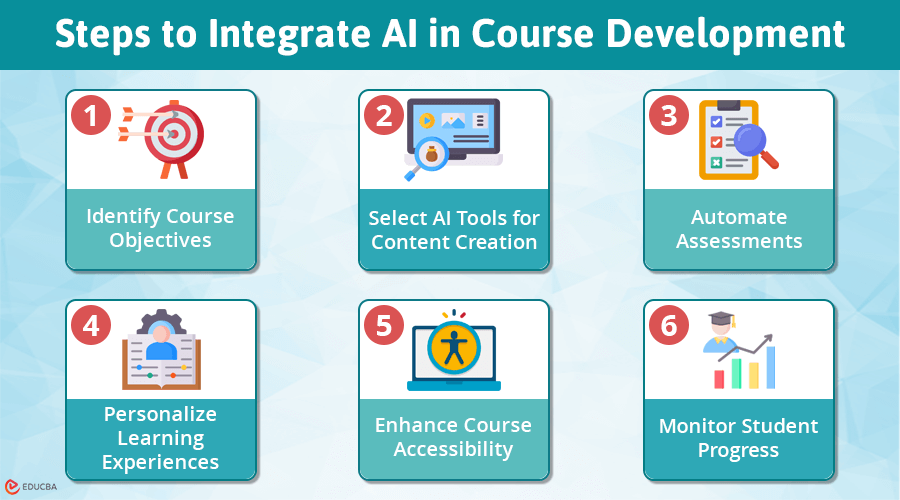
What is AI in Course Development?
AI in course development refers to using artificial intelligence tools and technologies to help create and improve educational courses. This can include automating tasks like grading assignments, personalizing learning experiences for students, and generating interactive content such as quizzes and study materials.
Essentially, AI makes it easier for educators to design effective courses that meet the diverse needs of their students, making learning more engaging and tailored to individual learning styles.
Steps to Integrate AI in Course Development
Here are the steps to effectively incorporate AI in course development:
Step 1: Identify Course Objectives
Using Gen AI in a learning and development course begins with clearly defining what you want your students to learn. First, determine the skills and knowledge you want them to gain by the end of the course.
Whether you aim to enhance their critical thinking or introduce a new topic, AI can help refine these goals. For instance, AI can analyze student data and industry trends to align your course with current academic standards and employer expectations.
Using an AI course creation checklist, you can easily adjust your objectives to meet your student’s needs and ensure your course remains relevant.
Step 2: Select AI Tools for Content Creation
After setting your course objectives, the next step is to select the appropriate AI tools for creating content. AI-powered platforms, such as generative AI course creators, can handle much of the heavy lifting by generating interactive modules, quizzes, and personalized learning paths that cater to different learning styles.
For example, you can quickly and efficiently create quizzes or assignments tailored to your course topic. Using AI in course development increases student participation and keeps lessons relevant and engaging, ensuring students remain motivated and curious throughout the course.
Step 3: Automate Assessments
No matter what subject you teach, every educator knows that grading assessments take a lot of time. AI-powered tools can simplify and automate much of this process, reducing your workload while still providing quality feedback to your students.
AI can handle quizzes, multiple-choice questions, and essays, giving students quick feedback to help them understand their mistakes. This helps them learn and improve.
Automating assessments also gives you more time for important student interactions, like mentoring or having one-on-one discussions. Think about how much time you could save with AI taking care of these tasks.
Step 4: Personalize Learning Experiences
One of AI’s biggest advantages in education is its ability to customize learning for each student. By analyzing student performance, AI can recommend resources and materials that fit their unique learning speeds and styles. Imagine what it would be like if every student had a learning experience designed just for them!
If you have top-performing students, AI tools can suggest more challenging content to help them advance even further. On the other hand, if some students are having difficulties, generative tools can offer extra support to help them succeed in your courses.
Integrating AI not only helps you create and organize courses more efficiently but also promotes a more inclusive classroom for all learners.
Step 5: Enhance Course Accessibility
AI can make your courses easier for students with various learning needs. For instance, AI audio translators can automatically create transcripts, captions, and translations, allowing everyone to follow along with the material.
These tools can help you build a more welcoming and inclusive classroom for all students, regardless of their backgrounds or learning needs.
By using these resources, educators can create supportive learning environments for every student, which is especially important as inclusivity becomes a key focus in education today.
Step 6: Monitor Student Progress
Teachers need effective ways to track aeach student’s progress. AI-powered tools can provide analytics and reports that analyze how students engage with the course material.
For instance, you can generate a report for an individual student that breaks down their scores, shows how engaged they are with different parts of the course, and tracks their participation and learning speed.
This information allows you to adjust and improve the course material in real time to meet each student’s needs. It also helps you identify which students might need extra support so you can focus your efforts on helping them succeed.
Final Thoughts
Education is evolving, and integrating AI in course development is no longer optional—it is essential for creating the best learning experience possible. With AI, you can streamline grading, personalize learning, and provide the support students need to succeed.
Are you ready to transform your teaching with AI in course development? Start today and discover how these powerful tools can elevate your teaching and students’ learning experiences.
Recommended Articles
We hope this guide on integrating AI in course development has given you valuable insights. Check out these recommended articles for more strategies to enhance your educational practices and learning outcomes.

